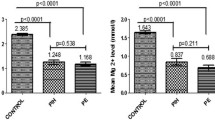Abstract
Objective
Pregnancy-induced hypertension and preeclampsia are serious clinical manifestations during late pregnancy and the cause for increased maternal and foetal morbidity and mortality. The pathogenesis is unknown but experience from treatment schemes suggests that minerals may be of importance. Mineral homeostasis is influenced by acid–base conditions. The aim of the study was to elucidate the relation between acid–base balance, urinary mineral excretion and blood pressure during pregnancy.
Design
A prospective observational study of a general population.
Materials and methods
The study was performed at the Midwife Health Center in Borås, Sweden, where practically all pregnant subjects in the catchment area are registered. First time pregnant subjects (n = 123) were voluntarily recruited without exclusion criteria. A 24 h urine sample was collected at pregnancy week 12 and analyzed for creatinine, calcium, magnesium, and urea as a proxy for acid conditions. Blood pressure was recorded every 2–3 weeks until delivery.
Results
There was a relation between the excretion of urea and calcium and magnesium at week 12. A blood pressure increase was found after pregnancy week 30 but only among subjects who had a high excretion of calcium and magnesium at week 12.
Conclusions
If an increase in blood pressure during the later part of pregnancy a risk indicator for preeclampsia, the results suggest that an excessive secretion of calcium leading to a functional deficit might be a risk indicator for gestational hypertension and preeclampsia. Intervention experiments are required to assess this hypothesis.



Similar content being viewed by others
References
López-Jaramillo P, Garcia RG, López M (2005) Preventing pregnancy-induced hypertension: are there regional differences for this global problem? J Hypertens 23:1121–1129
Moffet-King A (2002) Natural killer cells and pregnancy. Nat Rev Immunol 2:656–663
Richie LD, King JC (2000) Dietary calcium and pregnancy-induced hypertension: is there a relation? Am J Clin Nutr 71(Suppl):1371–1374
Suarez VR, Trelles JG, Miyahira JM (1996) Urinary calcium in asymptomatic primigravidas who later developed preeclampsia. Obstet Gynecol 87:79–82
Taufield PA, Ales KL, Resnick LM, Druzin ML, Gertner JM, Laragh JH (1987) Hypocalcuria in preeclampsia. New Engl J Med 316:715–718
Bucher HC, Guyatt GH, Cook RJ, Hatala R, Cook DJ, Lang JD, Hunt D (1996) Effect of calcium supplementation on pregnancy-induced hypertension and preeclampsia—a meta analysis of randomized controlled trials. JAMA 275:1113–1117
Villar J, Abdel-Aleem H, Merialdi M, Mathai M, Ali MM et al (2006) World health organisation randomized trial of calcium supplementation among low calcium intake pregnant women. Am J Obstet Gyn 194:639–649
Hofmeyr GJ, Atallah AN, Duley L (2008) Calcium supplementation during pregnancy for preventing hypertensive disorders and related problems. Cochrane Lib 4:1–51
Trumbo PR, Ellwood KC (2007) Supplemental calcium and risk reduction of hypertension, pregnancy-induced hypertension, and preeclampsia: an evidence-based review by the US Food and Drug Administration. Nutr Rev 65:78–86
Remer T, Mantz F (1995) Potential renal acid load of foods and its influence on urine pH. J Am Diet Assoc 95:791–797
Lutz J (1984) Calcium balance and acid–base status of women as affected by increased protein intake and by sodium bicarbonate ingestion. Am J Clin Nutr 39:281–288
Rylander R, Remer T, Berkemeyer S, Vormann J (2006) Acid–base status affects renal magnesium losses in healthy, elderly persons. J Nutrition 136:2374–2377
Rylander R, Tallheden T, Vormann J (2009) Acid-base conditions regulate calcium and magnesium homeostasis. Magnes Res 22:262–265
Lain KY, Roberts JM (2002) Contemporary concepts of the pathogenesis and management of preeclampsia. JAMA 287:3183–3186
Roberts JM, Pearson G, Cutler J, Indheimer M (2003) Summary of the NHLBI working group on research on hypertension during pregnancy. Hypertension 41:437–445
Sibai B, Dekker G, Kupfeminc M (2005) Pre-eclampsia. Lancet 365:785–799
Sanchez-Ramos L, Sandroni S, Andres F, Kaunitz A (1991) Calcium excretion in preeclampsia. Obstetr Gynecol 77:510–513
Saudan PJ, Shaw L, Brown MA (1998) Urinary calcium/creatinine ratio as a predictor of preeclampsia. Am J Hypertens 11:839–843
Conflict of interest statement
None.
Author information
Authors and Affiliations
Corresponding author
Rights and permissions
About this article
Cite this article
Nielsen, T.F., Rylander, R. Urinary calcium and magnesium excretion relates to increase in blood pressure during pregnancy. Arch Gynecol Obstet 283, 443–447 (2011). https://doi.org/10.1007/s00404-010-1371-y
Received:
Accepted:
Published:
Issue Date:
DOI: https://doi.org/10.1007/s00404-010-1371-y




